AMD's Young Turks - Radeon HD 6670 and 6570
AMD has released the last member of its Northern Islands GPU family - Turks. Known as the new Radeon HD 6670 and the Radeon HD 6570, do these entry level graphics card improve on their predecessors? We also check out the recently released retail editions of the Radeon HD 6450 and GeForce GT 520 to figure out how the Turks fares.
It Ends with the Turks
And it's done. Six months after AMD launched the first member of its Northern Islands GPU family, Barts, in the form of the , the last GPU for this generation, Turks has been introduced. Released as the Radeon HD 6670 and Radeon HD 6570, Turks is aimed at the entry level segment, which also means that AMD has refreshed its entire range of graphics cards, from the highest tier enthusiast product, the dual-GPU , to the lowest Radeon HD 6450 (released initially as an OEM part).
As their model names suggest, the Radeon HD 6670 and 6570 are designed to replace its Redwood-based predecessors, the and . Given the mostly similar architectures between the Northern Islands and Evergreen GPU families, the Radeon HD 6670 and 6570 represent a slight boost in performance over the previous generation. An additional SIMD engine ensures that the Turks get 80 more stream processors and four more texture units, along with the various updated technologies found on the Radeon HD 6000 series, .
The core clock on the Radeon HD 6670 also gets a slight increase to 800MHz from 775MHz, though the Radeon HD 6570 remains unchanged from the 5670 at 650MHz. The memory bus remains the same at 128-bit, with similar 1GHz base memory clock on both the 6670 and the 5670 (which results in 4000MHz with GDDR5 memory). The 6570 also gets the GDDR5 option, which would be an improvement over the 5570's DDR3 default. As a result, we expect a significant performance gulf between the 6570 and the 5570, especially when it comes to memory bandwidth.
With both series on the same 40nm manufacturing process from TSMC, the additional SIMD engine, while providing a performance increase, does imply a slightly larger die, and one can expect a correspondingly minor jump in TDP and power consumption.
We didn't quite manage to get the Radeon HD 6450 when it was first launched a couple of weeks back, but we do have it now and we've also included this most basic and low-end of the Radeon HD 6000 series as part of this feature. With a different core, Caicos, the Radeon HD 6450 is a far cry from the Turks, with just 160 stream processors and just eight texture units. A 64-bit memory bus completes its entry level specifications and while GDDR5 versions are available, the memory bandwidth by itself won't produce any miracles. On paper, the 6450 has twice the stream processors as the previous 5450, which some of you may know, is now finding new life as part of the . It should help the newcomer differentiate itself from the 5450, but it will face an uphill task convincing users that it's more than just integrated graphics.
It's a lot to take in, so after our 'glamor' shot of the three new Radeon HD cards below, we have our usual table comparing the specifications of these GPUs, together with some of its probable competitors, both old and new. We recommend expanding the page view mode to 100% to view the table comparison in proper.

While the reference AMD cards came with small fans, manufacturers like HIS are taking the opportunity of these low-power, low-end cards to go with passive coolers. The sole Sapphire card here, a Radeon HD 6670 meanwhile comes with a cooler from Arctic Cooling.
Model | AMDRadeon HD6670 | AMDRadeon HD6570 | ATI Radeon HD 5670 | ATIRadeon HD5570 | NVIDIAGeForce GT520 | NVIDIAGeForce GT 430 | ATIRadeon HD 6450 | ATIRadeon HD 5450 |
Core Code | Turks XT | Turks PRO | Redwood XT | Redwood PRO | GF119 | GF108 | Caicos | Cedar PRO |
Transistor Count | 716 million | 716 million | 627 million | 627 million | Unknown | 585 million | 370 million | 292 million |
Manufacturing Process | 40nm | 40nm | 40nm | 40nm | 40nm | 40nm | 40nm | 40nm |
Core Clock | 800MHz | 650MHz | 775MHz | 650MHz | 810MHz | 700MHz | 625 - 750MHz | 650MHz |
Stream Processors | 480 Stream Processing Units | 480 Stream Processing Units | 400 Stream Processing Units | 400 Stream Processing Units | 48 Stream Processors | 96 Stream Processors | 160 Stream ProcessingUnits | 80 Stream Processing Units |
Stream Processor Clock | 800MHz | 650MHz | 775MHz | 650MHz | 1620MHz | 1400MHz | 625 - 750MHz | 650MHz |
Texture Mapping Units (TMU) or Texture Filtering (TF) units | 24 | 24 | 20 | 20 | 8 | 16 | 8 | 8 |
Raster Operator units (ROP) | 8 | 8 | 8 | 8 | 4 | 16 | 4 | 4 |
Memory Clock | 4000MHz GDDR5 | 4000MHz GDDR5 / 1800MHz DDR3 | 4000MHz GDDR5 | 1800MHz DDR3 | 1800MHz DDR3 | 1800MHz DDR3 | 1066 to 1600MHz DDR3 / 3200 to 3600MHz GDDR5 | 1600MHz DDR3 |
DDR Memory Bus | 128-bit | 128-bit | 128-bit | 128-bit | 64-bit | 128-bit | 64-bit | 64-bit |
Memory Bandwidth | 64GB/s | 64GB/s / 28.8GB/s | 76.8GB/s | 28.8GB/s | 14.4GB/s | 28.8GB/s | 8.5 to 12.8GB/s (DDR3) / 25.6 to 28.8GB/s (GDDR5) | 12.8GB/s |
PCI Express Interface | PCIe ver 2.1 x16 | PCIe ver 2.1 x16 | PCIe ver 2.0 x16 | PCIe ver 2.0 x16 | PCIe ver 2.0 x16 | PCIe ver 2.0 x16 | PCIe ver 2.1 x16 | PCIe ver 2.0 x16 |
Molex Power Connectors | None | None | None | None | None | None | None | None |
Multi GPU Technology | CrossFireX | CrossFireX | CrossFireX | CrossFireX | None | None | None | None |
DVI Output Support | 1 x Dual-Link | 1 x Dual-Link | 2 x Dual-Link | 2 x Dual-Link | 1 x Dual-Link | 2 x Dual-Link | 1 x Dual-Link | 2 x Dual-Link |
HDMI | 1 (ver 1.4a) | 1 (ver 1.4a) | 1 | 1 | 1 | 1 | 1 (ver 1.4a) | 1 |
DisplayPort | 1 (ver 1.2) | 1 (ver 1.2) | 1 | 1 | None | None | 1 (ver 1.2) | 1 |
HDCP Output Support | Yes | Yes | Yes | Yes | Yes | Yes | Yes | Yes |
Street Price | Launch Price: US$99 | Launch Price: US$79 | ~US$70 - 85 | ~US$50 - 75 | ~US$60 | ~US$70 | ~US$55 | ~US$55 |
Among the cards compared above, we have of course previously covered the Radeon HD 5670 and 5570. You can find out more about these budget cards . As for the newer GeForce GT 520, it has been around, but in the form of the mobile GPU 520M. Given that it was released shortly after AMD introduced the Radeon HD 6450, one can speculate that NVIDIA brought it out in retail to match the 6450, especially when their suggested retail prices differ by just US$5. On paper, it looks like the successor to the GT 220, but not in a good way; the specifications look as weak and at times, even worse than the 220. You can compare the specs for the GeForce GT 520 listed above with the old GeForce GT 220 .
We'll be testing the GT 520 along with the other new Radeon HD cards, but the focus for the day remain AMD's Turks and Caicos.
Sapphire Radeon HD 6670 1GB GDDR5
Sapphire has decided to go with a dual-slot fan design instead of the reference design that has been making the rounds from AMD. Obviously, the manufacturer is targeting a different group of users with its Radeon HD 6670, with a seemingly buffed up cooler from Arctic Cooling. This is one card that's not for the HTPC market but it's your choice to use it if you can fit this in your intended system. Aside from the non-standard cooler, this Sapphire card comes with the standard clock speeds, which is 800MHz for the core and 4000MHz DDR for the 1GB GDDR5 memory.
The SRP for the Radeon HD 6670 may be US$99, but we found the Sapphire going for around US$97 at online retailers. Considering its third-party cooler, it does seem like a decent deal.

The Sapphire Radeon HD 6670 is a relatively short, stubby card which takes up two slots due to its larger, third-party cooler.

All the display outputs that you would need - DisplayPort 1.2, HDMI 1.4a and a dual-link DVI output.

Arctic Cooling provides the cooler for this card and to our ears, it's silent enough. We'll see if it manages to keep it cool.
HIS Radeon HD 6570 Silence 1GB GDDR5
HIS meanwhile, has decided to focus on the low-power and low TDP aspect of the Turks GPU and has outfitted its Radeon HD 6570 with a passive cooler. While the rear bracket may be a single-slot, the fins on this passive heatsink effectively takes up another slot besides the graphics card. So, you'll have to ensure that there's sufficient space for this graphics card. Unlike the reference design, which is low-profile, this is a full sized (height-wise), albeit short card.
The clock speeds are standard too, with its 650MHz core complemented by an effective memory frequency of 4000MHz with GDDR5 memory. Take note that HIS has a similarly passively cooled DDR3 version of the Radeon HD 6570 with 1GB of memory. That version uses a truly single-slot passive cooler, so it's an alternative if chassis space is an issue. We weren't able to get the retail price for this HIS Silence, but we expect the price to be within the SRP of US$79, with perhaps a slight premium for the passive cooling.

A huge chunk of fins and cold metal make up the passive cooler on this HIS Radeon HD 6570 Silence.

You may not be able to tell from this, but the heatsink on this card practically takes up two slots worth of space.

A closer look at the fins of the passive cooler.
HIS Radeon HD 6450 Silence 1GB GDDR5
The Radeon HD 6450 also gets the passive cooling treatment, distinguishing it from the reference design. We doubt that HIS is the only vendor taking this approach, as the low-profile, low-power nature of the Radeon HD 6450 makes it most appropriate for HTPC and quiet desktop configurations. With the exception of the heatsink, this HIS card is identical to the typical Radeon HD 6450, though this card is clocked at the lowest end of the spectrum for the Radeon HD 6450.
If you can recall from our specs listing, the Radeon HD 6450 can be clocked from between 625MHz to 800MHz for the core and it can come with a DDR3 or GDDR5 memory config. While HIS has gone with 1GB of GDDR5 memory, it is at a relatively slower 800MHz (or 3200MHz DDR equivalent) and the core clock of 625MHz is at the lowest possible spectrum. That should lower any expectations that you may have for this card, though we'll also be overclocking it later to find out the difference in performance.

HIS has replaced the standard cooler on the reference Radeon HD 6450 with its own passive version.

The low-end nature of this SKU means that VGA is still an option, along with DisplayPort and DVI.
Test Setup
Our usual X58 testbed, which consists of the following configuration, will be used to evaluate the performance of these graphics cards.
- Intel Core i7-975 (3.33GHz)
- Gigabyte GA-EX58-UD4P motherboard
- 3 x 1GB DDR3-1333 G.Skill memory in triple channel mode
- Seagate 7200.10 200GB SATA hard drive
- Windows 7 Ultimate
These new AMD Radeons are targeted at the lower end and entry level segment, with the most expensive, the Radeon HD 6670 priced just below US$100. Hence, we have also included some of its competitors in this admittedly narrow price range, like the GeForce GT 520 (~US$60), the GeForce 430 (~US$70), as well as older Radeons like the Radeon HD 5570 and 5670, which are still pretty competitive in this segment. While we would have liked to show how these cards compare with a slightly higher tier of cards like the 6700 series from AMD and GeForce GT 550 from NVIDIA, they are quite a lot faster than these lower tier graphics cards and would have made the comparisons a lot messier.
Here are the full list of cards tested and the driver versions used:
- Sapphire Radeon HD 6670 1GB GDDR5 (Catalyst 11.4)
- HIS Radeon HD 6570 Silence 1GB GDDR5 (Catalyst 11.4)
- HIS Radeon HD 6450 Silence 1GB GDDR5 (Catalyst 11.4)
- NVIDIA GeForce GT 520 (ForceWare 270.61)
- NVIDIA GeForce GT 430 (ForceWare 259.36)
- ATI Radeon HD 5670 (Catalyst 10.9)
- ATI Radeon HD 5570 (Catalyst 10.9)
For these entry level graphics cards, we have revised our benchmarks with less demanding settings, though that's still no guarantee of playable frames in some cases:
- Futuremark 3DMark Vantage
- Crysis Warhead (Overall settings: Mainstream)
- Far Cry 2 (Overall settings: High)
- Warhammer: Dawn of War 2 (Overall settings: Low)
- Battlefield Bad Company 2 (Overall settings: Low)
- "Heaven" from Unigine v2.1 (Overall settings: Low)
- S.T.A.L.K.E.R.: Call of Pripyat (Overall settings: Medium)
3DMark Vantage Results
We start off with 3DMark Vantage as a quick gauge on where these graphics cards stand. As expected, the Sapphire Radeon HD 6670 was ahead of the rest, with close to 3000 3DMarks at Extreme. It was around 20% faster than the 6570, which is quite logical when you account for the discrepancy between their core clocks (800MHz vs 650MHz). With the older Radeon HD 5670 just a notch behind the 6570, one could say that the Turks represent a decent amount of progress.
At the bottom of the heap was the Radeon HD 6450, which was much slower than the GT 520 (which in itself is actually not better than a GeForce GT 220) . With the older but price competitive GT 430 still around, it's really hard to see where the newer GT 520 and Radeon HD 6450 stand. They are not much better than the best IGP units around.

Crysis Warhead and Far Cry 2 Results
The scores in Crysis Warhead, at mainstream settings mostly mirrored what we saw in 3DMark Vantage. The Sapphire Radeon HD 6670 was way ahead of the chasing pack, with the 6570 narrowly beating the existing 5670. Our reference 5570, with its 512MB of memory was much further back, but it too had a substantial advantage over the GT 430 and the lower tier cards.
Where we had seen the Radeon HD 6450 losing badly to the GT 520, it was a more even competition in Crysis Warhead, with the Radeon beating the GT 520 slightly. In reality however, it won't really matter who comes out tops, since even at 1280 x 800 and without AA, these bottom cards barely manage the minimum 30 frames. Speaking of anti-aliasing, surprisingly, the presence of AA hardly bothered the performance of even these low-end graphics cards.


Moving on to Far Cry 2, it was more of the same, though NVIDIA appeared to fare better, with the GT 430 now catching up with the Radeon HD 5570. We also saw the GT 520 edging in front of the Radeon HD 6450 in a reverse of what we had seen in Crysis Warhead. At these settings though, you'll want at least a Radeon HD 6570 to ensure smooth gameplay, especially at 1920 x 1200 and with 4xAA.


Dawn of War 2 & Battlefield Bad Company 2 Results
Dawn of War 2 is probably the only game where all these cards here can produce decent, playable frames. Even at 1920 x 1200, the slowest duo of the Radeon HD 6450 and GT 520 was churning at least 30 frames per second. The Turks based Radeons however showed that they didn't belong here with the rest, with frame rates that were almost double that of the previous generation 5670 and 5570. It's as good an endorsement of the new Radeons as any we have seen so far.

Normal service was resumed in Battlefield Bad Company 2, with the Turks significantly faster than the old Redwoods while the Radeon HD 6450 and GT 520 languished at the bottom, with barely playable frame rates at even the low image quality settings.

Unigine "Heaven" 2.1 Results
We calibrated the settings to low for Unigine, but the DirectX 11 tests were still too demanding for even the Radeon HD 6670. As for the Radeon HD 6450 and GT 520, the less said the better, as they produced single-digit frames. The Radeon HD 6450 also didn't support 8x AA, which was why we had no scores for that. No doubt, this benchmark is targeted at more powerful graphics cards, but it again illustrates the hollowness of such low-end graphics cards and their support for DirectX 11.
The DirectX 10 scores were slightly better, but only the Turks based Radeons emerged with somewhat decent results.
DirectX 11 Results


DirectX 10 Results


S.T.A.L.K.E.R.: Call of Pripyat Results
At Medium settings, there was some hope for the lowest end cards here, especially in DirectX 10 at more modest resolutions and with anti-aliasing disabled. The Radeon HD 6450 remained last however, with the GT 520 marginally faster. At the top, the Radeon HD 6670 was clearly the leader, with the 6570 unfortunately closer to the 5670 than the 6670. There was nevertheless sufficient evidence and a significant gap between the new and old to argue for the Radeon HD 6670 and 6570.
DirectX 11 Results
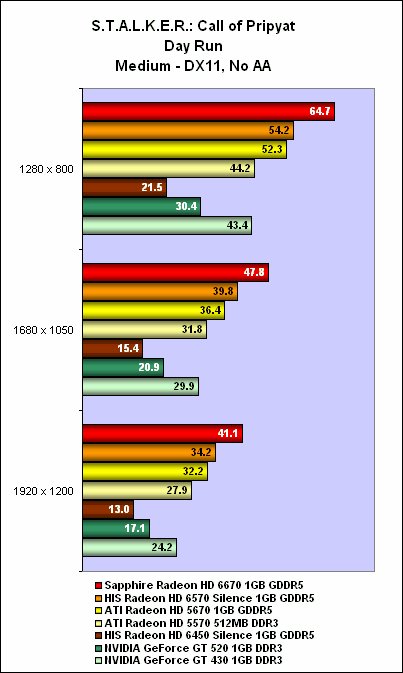 | 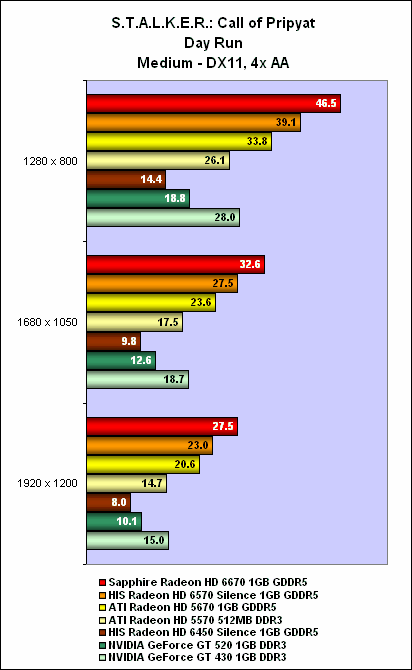 |
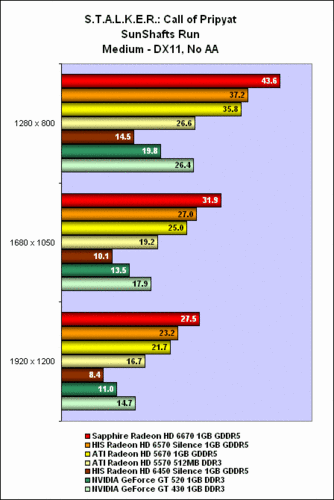 | 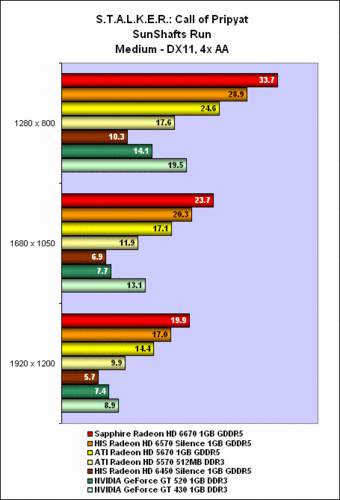 |
DirectX 10 Results
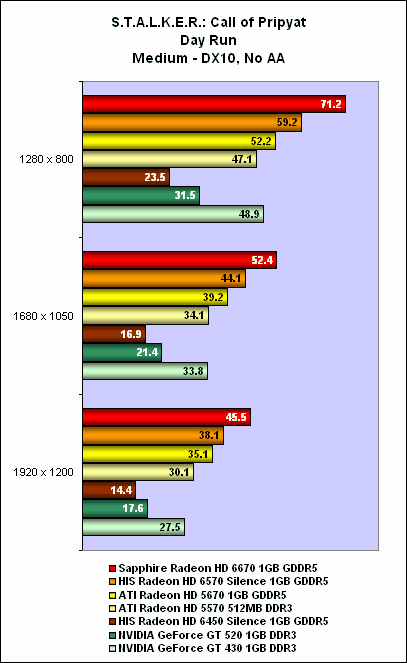 | 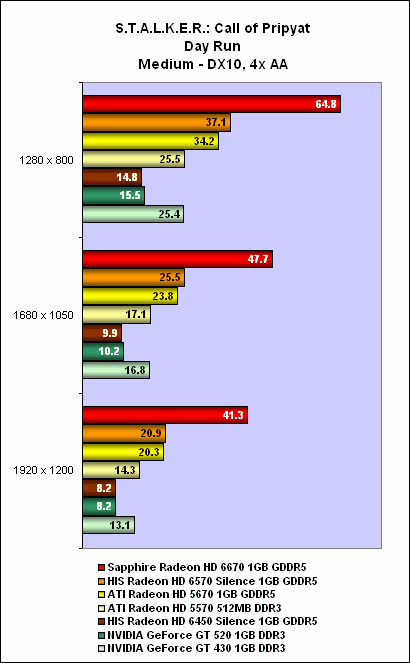 |
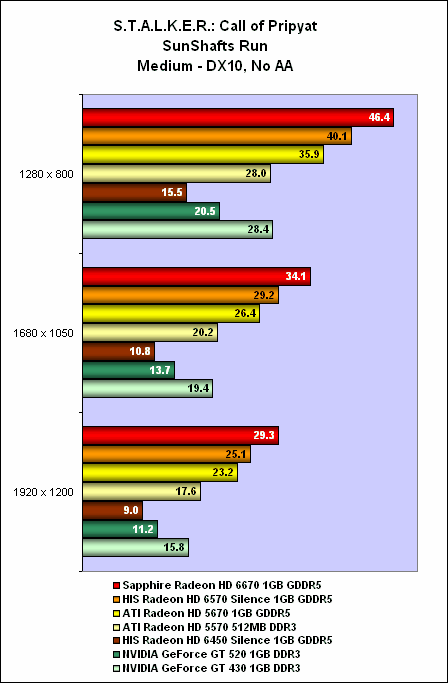 | 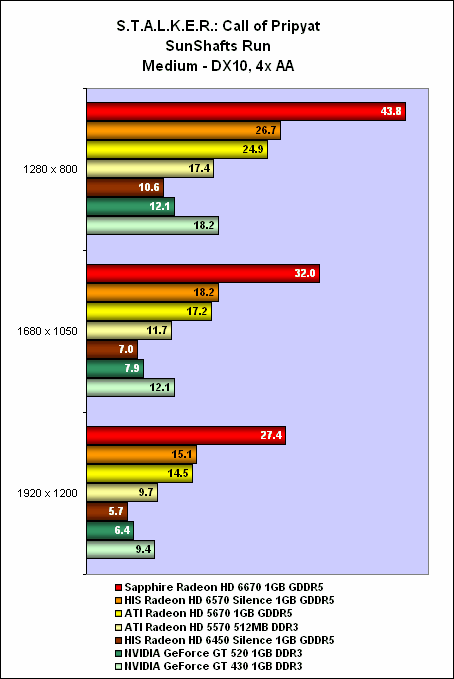 |
Temperature
Passive cooling on the HIS 6570 and 6450 Radeon cards ensures that the temperatures for them are significantly higher than the others here, but going with the 54 degrees Celsius on the Sapphire Radeon HD 6670, which is using an Arctic Cooling solution, we can probably expect the majority of these cards to be in this ballpark, with 60 degrees the likely upper limit. Compared to the more powerful graphics cards in the market now, these are very modest load temperatures that reflect their low TDP.

Power Consumption
Going by the slightly higher TDP ratings for the Radeon HD 6670 and 6570 (66W and 60W respectively) over the previous generation (61W for the 5670 and 42.7W for the 5570), one might feel that the performance gain comes at a cost. In practice, the costs look very minor compared to the gains, with a negligible increase of 1W for both idle and load power draw for the 6670 from the 5670. It was more obvious when comparing the 6570 and the 5570, though to be fair, our 5570 came with half the memory (512MB) and was the slower DDR3 variant.
The Radeon HD 6450 meanwhile had identical power consumption as its probable competitor, the GT 520, which isn't great for AMD considering that it lagged slightly behind the GT 520 in our benchmarks.
Overall, all these low-end graphics cards did an admirable job of keeping the power consumption low and makes a strong case for their inclusion in low-power systems - if you can benefit from their limited performance profile and unique features.

Overclocking
Now that we have seen how these entry level Radeons perform at their standard clocks, we tried our hand at overclocking them (not that we expect the typical user to be trying this at home). It was interesting to see that despite going up to 950MHz for the core, the 6670 was still some distance behind the GeForce GTS 450, which represents the next performance rung. It probably means even a heavily overclocked variant from any manufacturer will not match the GTS 450, so you're better off just getting the 450 if you have the budget.
If you're scraping the bottom of the barrel, the 6570 could be a decent substitute for the 6670 provided you can push the clock speeds up. Given their similarities, that's no surprise, especially if you have a 1GB 6570.
Finally, we also pushed the Radeon HD 6450 to the maximum specified clocks as dictated by AMD, which is 750MHz (core) and 3600MHz DDR. This gave around 23% boost in performance for 3DMark Vantage; hopefully that helps your purchasing decision when considering the possible variants offered by manufacturers. Pushing it further yielded a 3DMark score that came close to the GT 520, but honestly, there's a reason why the GT 520 is that little bit more expensive.

Mission Accomplished
With the release of these Radeons, AMD can give itself a pat on its back for releasing its entire Radeon HD 6000 series within half a year. While there have been slight hiccups along the way, with the delay of some SKUs, AMD has managed to get the job done and hopefully, the company has its sights set on the next generation. The Radeon HD 6000 series is frankly an extension of the 5000 series and with NVIDIA back in the game after its slow start with Fermi, AMD needs either a new architecture or a die shrink to push the envelope further.
While the enthusiasts eagerly await this next generation, expected in the second half of 2011, the majority of the users will likely have one of these newly released Radeons. These users may not always know the model of the graphics card in their systems, but these entry level cards, with their dedicated hardware for handling HD video playback (aka UVD3) will be the workhorses that will see them through their casual games, and perhaps even more demanding games, at the right settings of course.
Looking at the Turks based Radeon HD 6670 and 6570, one gets a sense of progress, with the 6570 getting the better of the 5670. The degree of the improvement varies depending on the games, but it's there and gives users a reason for getting these newer cards. The similarities in the architecture means that this improvement is almost certainly derived from the additional SIMD on the Turks GPU. Although that does lead to a slightly higher TDP, the gains outweigh the costs and from what we have seen, the power consumption and resultant temperatures were quite similar with the previous generation.
At around US$99 for the Radeon HD 6670, it's in between the US$130 GeForce GTS 450 and the US$70 GeForce GT 430, with a decent gap for it to thrive comfortably. Or so it would seem.
Compared to the Turks, the Caicos or Radeon HD 6450 is much less persuasive, both in performance and price. With Intel HD Graphics on Sandy Bridge and AMD's own Brazos platform (using a 5450 derivative) raising the overall level of integrated graphics, AMD needed a solution to bridge the gap between integrated and discrete. This turned out to be the 6450, which does have the specifications to put the integrated graphics in its place, but it is still woefully entry-level to the point that it's not substantially better than integrated graphics.
NVIDIA though has added a new stumbling block in the form of the GT 520, which was previously a mobile variant, but now a strong challenger to the 6450. As we have seen, more often than not, the GeForce GT 520 is the faster card compared to the US$55 Radeon HD 6450, and with a SRP that's just US$5 more.
Personally, we'll say to check out the bargain bins first before getting any of these newer cards. Older SKUs like the GT 430 or the Radeon HD 5570 have shown that they are more than capable of beating the GT 520 or the Radeon HD 6450 and a discount or two will make them extremely price competitive. The same applies for the Turks, with a discounted GTS 450 posing the biggest threat if priced competitively.
As for the graphics cards we saw today, the Sapphire Radeon HD 6670 1GB GDDR5 comes with a dual-slot cooler from Arctic Cooling. It is priced competitively despite this and should provide decent value if you have the expansion slots to spare. HIS meanwhile sent us two passively cooled graphics cards, making them suitable for HTPC systems where silence is golden. With 1GB of GDDR5 memory on them, they have a decent amount of bandwidth and the 6570 in particular should do well with some overclocking. The HIS Radeon HD 6450 Silence however, suffers from having one of the slower, official clock speeds for its SKU. It will find its niche somewhere, but it will not be for its performance. Probable uses would be such as putting together a cheap system with used parts but a brand new entry level graphics card to ensure HD video processing and basic multimedia needs are serviced.
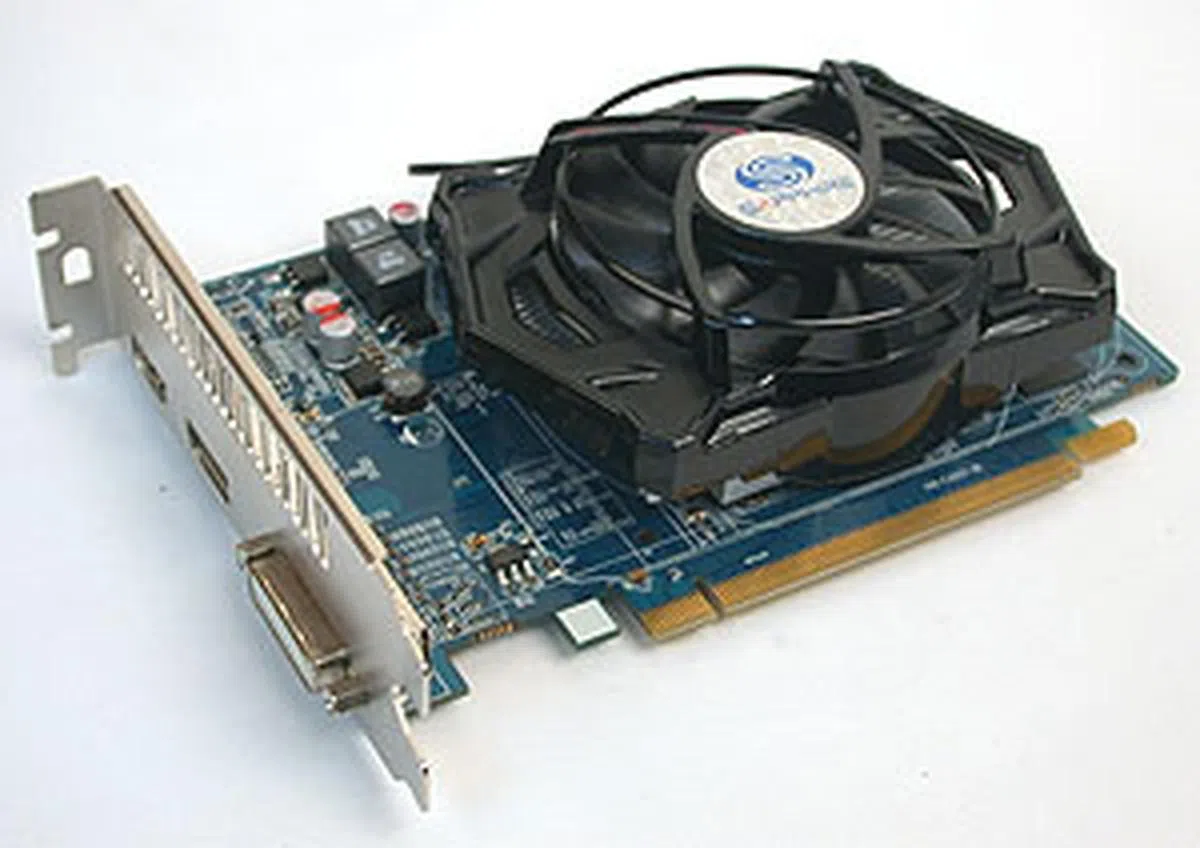 | 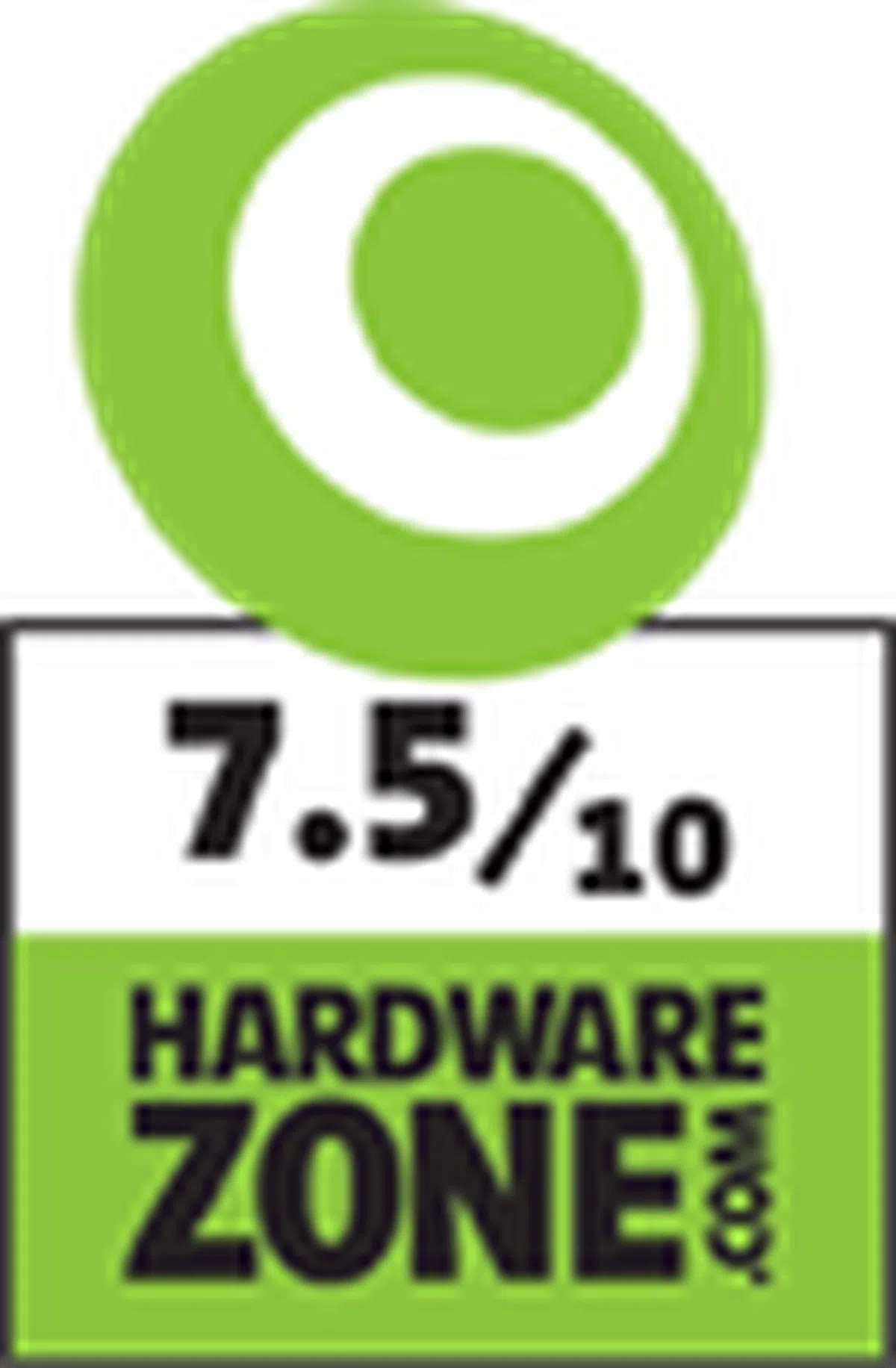 |
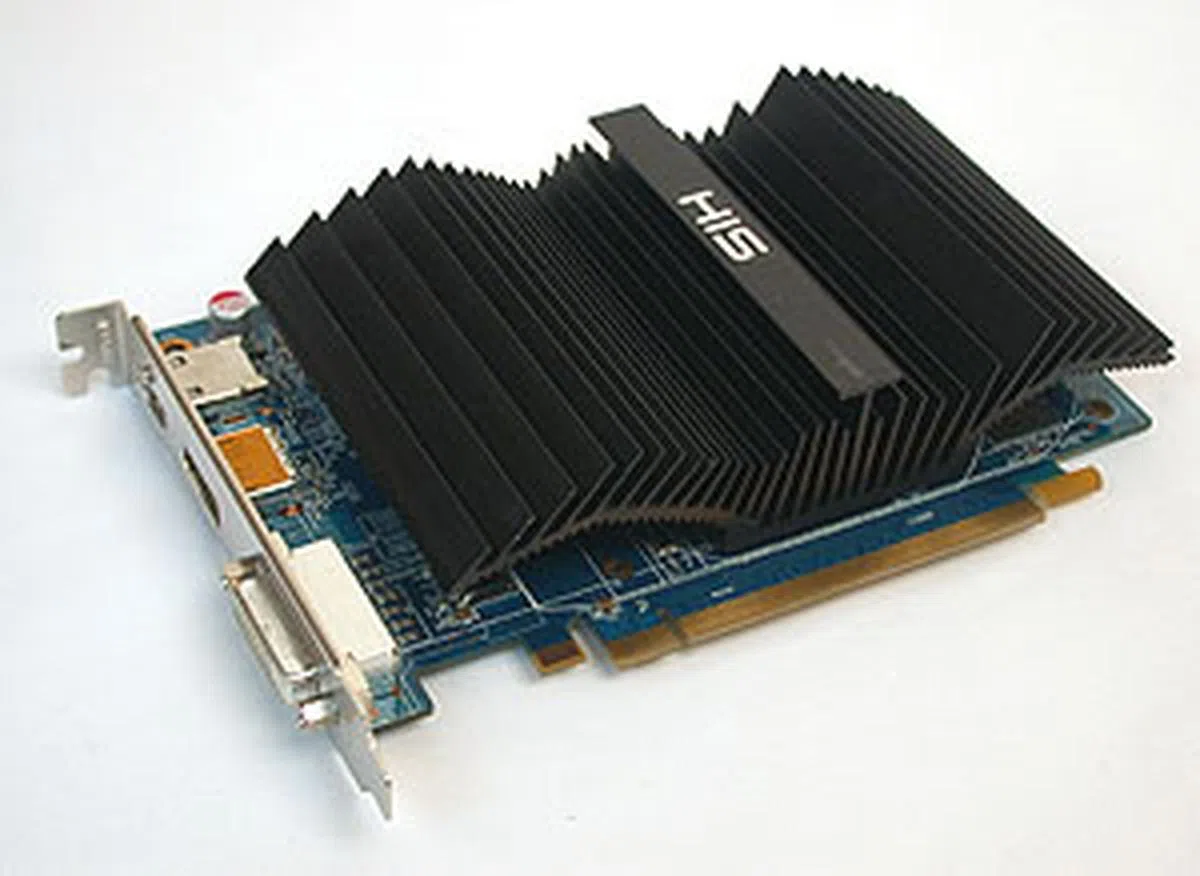 |  |
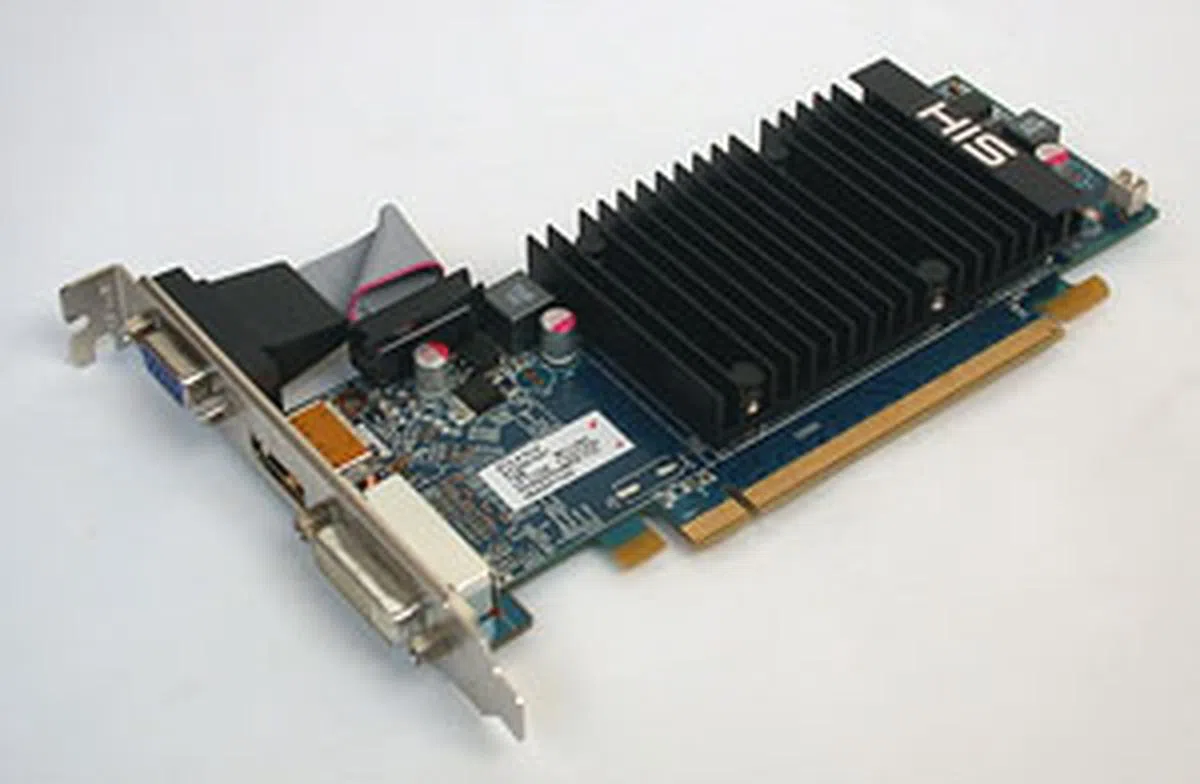 | 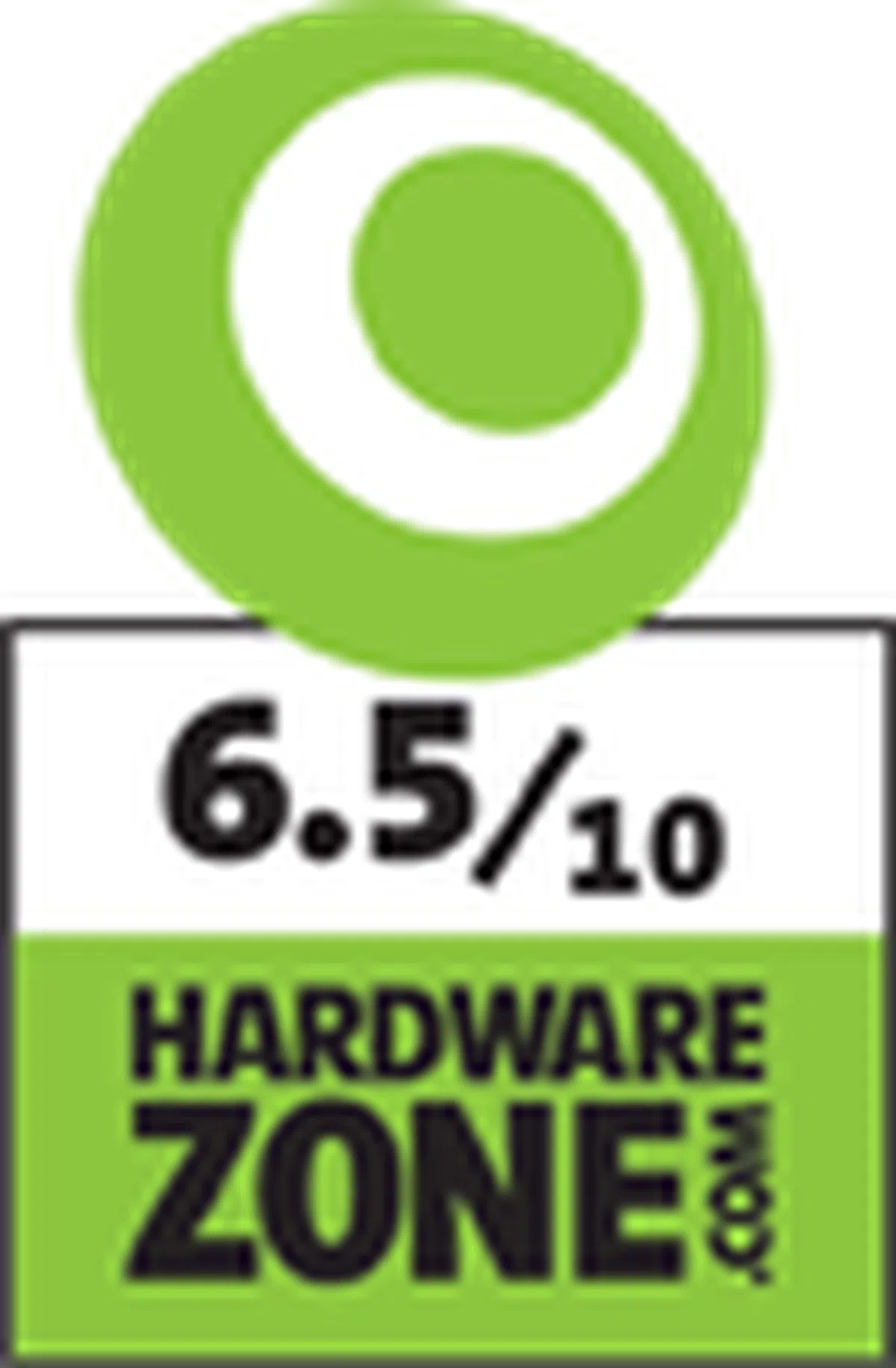 |
Our articles may contain affiliate links. If you buy through these links, we may earn a small commission.